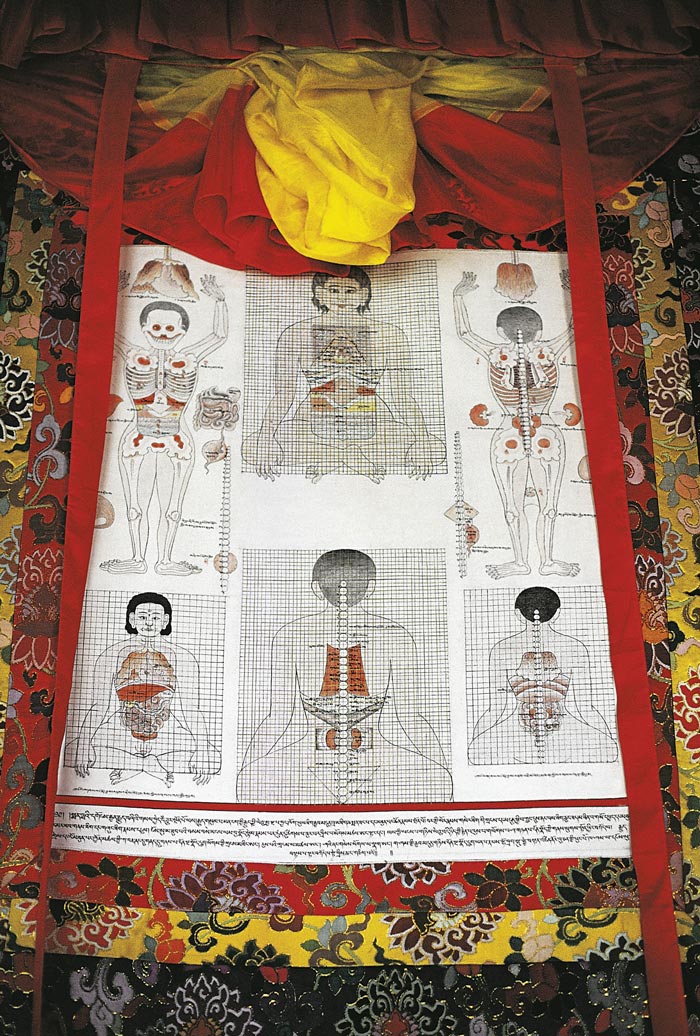Tibetan Medicine Under the Microscope
UVA Medical Center examines efficacy and possibilities of an ancient practice
Dr. Kunchok Gyaltsen rests his index, middle and ring fingers on the wrist of his demonstration patient, looking for the pulses there that, he says, feed him information about the woman’s organs, from her heart to her gallbladder.
Later, as his students watch, he will examine the woman’s urine, not with the complex chemical analyses common in Western medicine but through sight and smell, looking at the color and sediment and how the fluid responds to stirring. Then he will listen to his patient, patiently; if she was sick, he’d treat her with Tibetan herbs and oils from recipes first written down in the 17th century.

Gyaltsen, co-founder of Arura Medicine of Tibet, a nonprofit dedicated to improving health and preserving Tibetan techniques, says he is seeking the balance of earth and water, of fire and air and space—the elements that make up not just our bodies but our emotions as well. He’s teaching that balance in a course on Tibetan medicine there with Dr. Leslie Blackwell, director of palliative care at UVA Medical Center.
“We think heart and mind are linked, and more important is here,” Gyaltsen says, his mala beads clicking as he points to his chest. “The heart is the king of the castle.”
For 4,000 years, the people of the Himalayan region have relied on such concepts, and now Gyaltsen and his colleagues, working from an office suite above Charlottesville’s downtown mall, have begun collaborating with staff at the UVA Medical Center to teach them what Tibetan medicine might offer their patients while testing whether it holds up to Western scientific scrutiny.
“If someone in the field of the U.S. healthcare system accepts it, we believe the world will accept it,” says Gyaltsen, who earned his Ph.D. in public health from UCLA.
The Tibetans are working with a team of UVA scientists that includes Blackwell, a botanist, a cardiologist, a nurse-turned-therapist and a biomedical engineer. They’re designing studies to determine the efficacy of the herbal blend used to treat heart disease called semkyi dekyi, which translates to “mind happiness.” “People have studied why plants have certain effects, and we have an idea of what the different compounds are, but there may be 1,000 in any one plant,” says Michael Timko, a professor of biology and public health sciences at UVA “The Tibetan and Chinese and Indian doctors have figured out over thousands of years that there’s something active in these plants that causes an effect.”
His first job will be to confirm which plants are in semkyi dekyi, a task made more challenging by the fact that the Tibetan language must be translated into Chinese and then into English, since Tibetan plant names do not follow the same genus and species names used in the West.
Timko and research colleague John Herr, a professor of cell biology and biomedical engineering at UVA, plan to travel to Tibet to observe how the plants are harvested and processed, which makes a difference in how the combination might work.
“Maybe Plant A has these four compounds and Plant B has these four, and we can find that out,” Timko says, “but the interaction and synergy may be what’s important. And finding that out is complicated.”
Further complicating research is the Tibetan philosophy that the mind and body are intertwined, and that imbalance in one will lead to ill health in the other. That’s in contrast to Western medicine, whose doctors tend to treat individual body parts rather than the whole person.
“In a Tibetan medicine practice, the doctor and patient are very connected,” says Bobbi Llewellyn (Nurs ’69), a co-founder of the center and one of the UVA scientists. “It’s about building a relationship, about trust. But Western medicine is based on scientific method, and if you don’t have that, people are just going to raise their eyebrows.”
The Tibetans are also teaching UVA staff about meditation, mindfulness, nutrition and Tibetan massage, with the goals of both sharing their knowledge and preserving it, and with it a part of their culture.
“Scientifically, Tibetan medicine hasn’t been proven, so some people think it may not be good, so it could be lost,” Gyaltsen says. “That is why we’re here.”